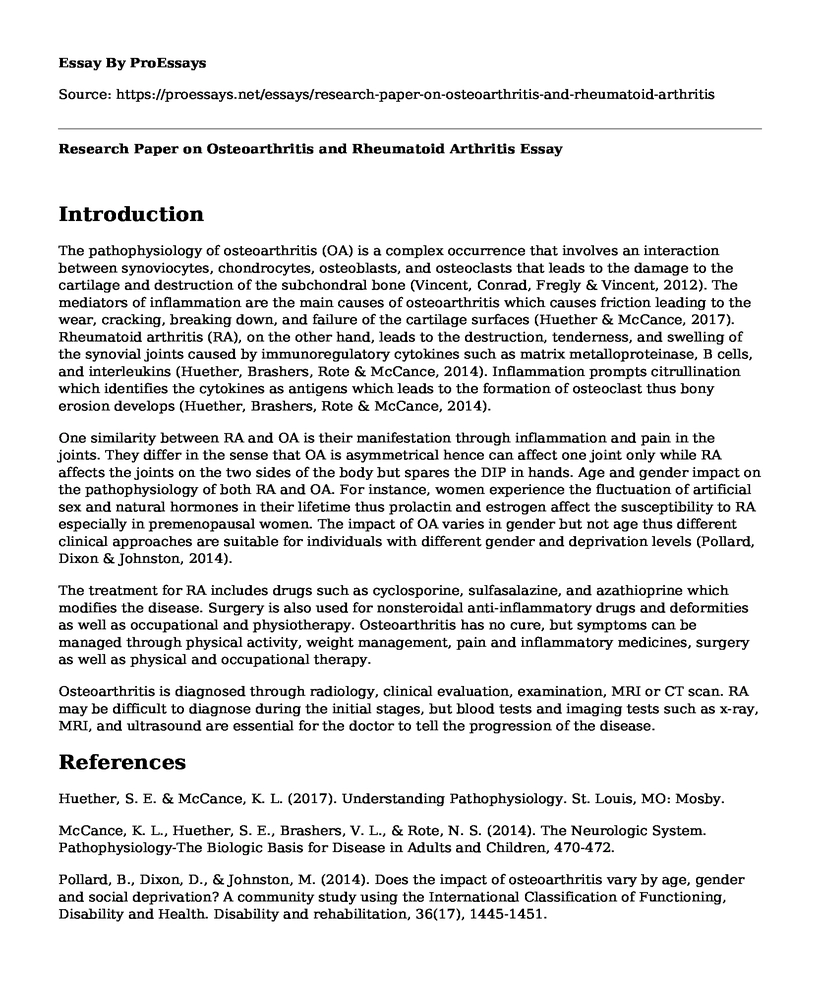Introduction
The pathophysiology of osteoarthritis (OA) is a complex occurrence that involves an interaction between synoviocytes, chondrocytes, osteoblasts, and osteoclasts that leads to the damage to the cartilage and destruction of the subchondral bone (Vincent, Conrad, Fregly & Vincent, 2012). The mediators of inflammation are the main causes of osteoarthritis which causes friction leading to the wear, cracking, breaking down, and failure of the cartilage surfaces (Huether & McCance, 2017). Rheumatoid arthritis (RA), on the other hand, leads to the destruction, tenderness, and swelling of the synovial joints caused by immunoregulatory cytokines such as matrix metalloproteinase, B cells, and interleukins (Huether, Brashers, Rote & McCance, 2014). Inflammation prompts citrullination which identifies the cytokines as antigens which leads to the formation of osteoclast thus bony erosion develops (Huether, Brashers, Rote & McCance, 2014).
One similarity between RA and OA is their manifestation through inflammation and pain in the joints. They differ in the sense that OA is asymmetrical hence can affect one joint only while RA affects the joints on the two sides of the body but spares the DIP in hands. Age and gender impact on the pathophysiology of both RA and OA. For instance, women experience the fluctuation of artificial sex and natural hormones in their lifetime thus prolactin and estrogen affect the susceptibility to RA especially in premenopausal women. The impact of OA varies in gender but not age thus different clinical approaches are suitable for individuals with different gender and deprivation levels (Pollard, Dixon & Johnston, 2014).
The treatment for RA includes drugs such as cyclosporine, sulfasalazine, and azathioprine which modifies the disease. Surgery is also used for nonsteroidal anti-inflammatory drugs and deformities as well as occupational and physiotherapy. Osteoarthritis has no cure, but symptoms can be managed through physical activity, weight management, pain and inflammatory medicines, surgery as well as physical and occupational therapy.
Osteoarthritis is diagnosed through radiology, clinical evaluation, examination, MRI or CT scan. RA may be difficult to diagnose during the initial stages, but blood tests and imaging tests such as x-ray, MRI, and ultrasound are essential for the doctor to tell the progression of the disease.
References
Huether, S. E. & McCance, K. L. (2017). Understanding Pathophysiology. St. Louis, MO: Mosby.
McCance, K. L., Huether, S. E., Brashers, V. L., & Rote, N. S. (2014). The Neurologic System. Pathophysiology-The Biologic Basis for Disease in Adults and Children, 470-472.
Pollard, B., Dixon, D., & Johnston, M. (2014). Does the impact of osteoarthritis vary by age, gender and social deprivation? A community study using the International Classification of Functioning, Disability and Health. Disability and rehabilitation, 36(17), 1445-1451.
Vincent, K. R., Conrad, B. P., Fregly, B. J., & Vincent, H. K. (2012). The pathophysiology of osteoarthritis: a mechanical perspective on the knee joint. PM&R, 4(5), S3-S9.
Cite this page
Research Paper on Osteoarthritis and Rheumatoid Arthritis. (2022, Jun 10). Retrieved from https://proessays.net/essays/research-paper-on-osteoarthritis-and-rheumatoid-arthritis
If you are the original author of this essay and no longer wish to have it published on the ProEssays website, please click below to request its removal:
- Nursing Professional and Academic Goals Essay
- Borrowed (Non-Nursing) Theories Applied to the Nursing Profession - Essay Sample
- The Responsibilities of Nurses in the Care and Handling of a Child
- Social Work Prof: Aims to Improve Lives & Create Opportunities - Essay Sample
- Paper Example on Fast Facts for LTC Nurse: A Guide for Nursing Students
- Essay Sample on GM Foods: Health Risks and Benefits Explored
- Paper Sample on Infant-Mother Attachment: Exploring the Secure Base







